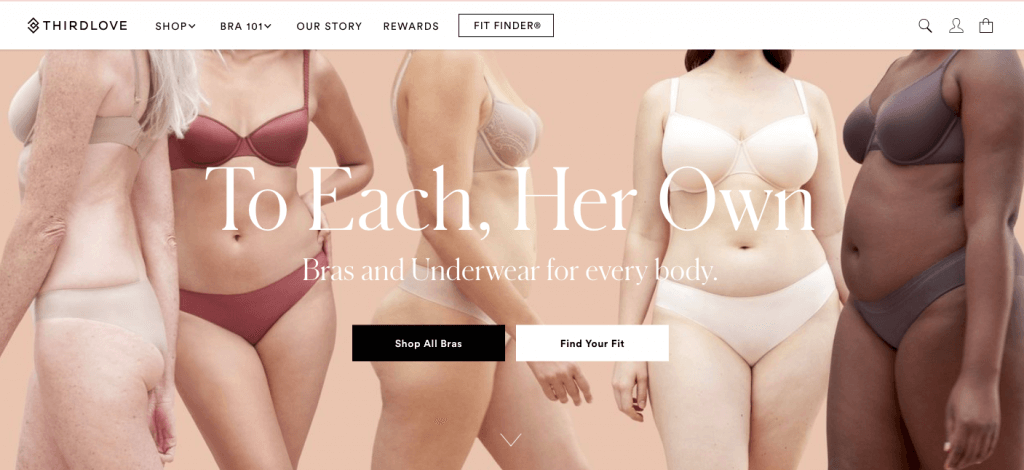Inside ThirdLove’s marketing war against Victoria’s Secret
The first time many people encountered a brand called ThirdLove was when the small lingerie startup took out a full-page ad in the New York Times to publicly flog Victoria’s Secret for their transphobia and thinly veiled misogyny.
Their open letter implanted a clear message of contrast in the minds of readers: Victoria’s Secret, with its patriarchal views on women and impossible beauty standards, is toxic for womankind. But ThirdLove? Come as you are. We want you to love your body as it is. This was quite a remarkable coup — a relatively small bra company positioning itself against a business several orders of magnitude larger and more influential on such a high-profile platform.
But the ploy was highly successful. The ad went viral online, garnering the company 19,000+ likes on Instagram and Twitter.
ThirdLove earned write-ups in highly coveted media publications like TeenVogue, Forbes and FastCompany for going up against Victoria’s Secret. Instant folk hero status unlocked. ThirdLove is not the only company out there banking on body positivity and diversity to sell lingerie. Notably, Rihanna’s Savage Fenty line has invested in a similar line of persuasion.
But when Victoria’s Secret's brand began imploding after its CMO Ed Razek’s comments to Vogue, it was ThirdLove that jumped at the opportunity to punch above its weight — not SavagexFenty.
So how did the company successfully break into mainstream discourse? How did ThirdLove manage to position itself as the archnemesis of Victoria’s Secret and emerge as the hero and protagonist?
The answer is “positioning.” ThirdLove put in the effort to develop a differentiated market position that it was able to then leverage when the time was right.
There are many ways to slice and dice this case, but I'm going to use Jack Trout's Four Steps to Differentiation (from his book Differentiate or Die) as a guide to break down ThirdLove’s successful differentiation strategy. Jack Trout, also known as the "Father of Positioning", considered marketing a battle for the customer's mind. Meanwhile, ThirdLove is growing its business through nothing less than marketing warfare – as if they've followed his steps to a T.
Let's take a look.
Four Steps To Differentiation: ThirdLove vs. Victoria's Secret
Step 1: Make Sense in the Context
“Arguments are never made in a vacuum. There are always surrounding competitors trying to make arguments of their own.” —Jack Trout, Differentiate or Die
This Victoria’s Secret PR debacle was not the first time I had heard of ThirdLove. They’ve been targeting me on Facebook for months, positioning themselves as an alternative to Victoria’s Secret.Notably, they were not just another bra company that just wanted me to buy a bra from them. Facebook ads like this indicated they wanted me to drop my Victoria’s Secret habit altogether.
No bra brand had ever explicitly made an argument for me to give up Victoria’s Secret completely. But what it suggested was clear: We can do everything Victoria’s Secret claims it does - and do it better.
“What you’re after are the perceptual strengths and weaknesses of you and your competitors as they exist in the minds of the target group of customers. What you really want to get is a quick snapshot of the perceptions that exist in the mind, not deep thoughts.”
During ThirdLove's PR coup, Cora Harrington (@lingerie_addict), author of “In Intimate Detail” observed that ThirdLove is not as radically inclusive as they were marketing themselves to be.For all the noise they kicked up about trans beauty, she pointed out that ThirdLove doesn’t work with trans models either.
They are not that inclusive on other fronts either, as they do not carry “most sizes.”
But this was exactly what ThirdLove was banking on — that they could win the battle for their customer’s perception without being the best alternative.All they had to do was create the perception that they are better than Victoria’s Secret.
Step 2: Find the Differentiating Idea
“The secret to this is understanding that your differentness does not have to be product related.”
ThirdLove’s differentiating idea is front and center on their website: Every body is different.
At ThirdLove, you’re not an imperfect being falling short of an impossible beauty standard. Come to ThirdLove as you are.
Again, this isn’t a radical or new idea. There are other brands out there with a similar body positivity schtick, such as True & Co. In contrast, Soma doesn’t seem to have invested in any differentiation or cultural messaging at all.
What ThirdLove did that competitors didn’t was to center their business around inclusivity messaging. While others tiptoed around the topic, ThirdLove went all in.
Step 3: Have the Credentials
"To build a logical argument for your difference, you must have the credentials to support your differentiating idea, to make it real and believable…You can’t differentiate with smoke and mirrors.”
ThirdLove has credibility — at least enough to carry through its marketing message.
Credential: Breast Shape Directory
While Victoria’s Secret was out sourcing supermodels that look exactly the same, ThirdLove was building this directory of differently shaped boobs. It’s a simple acknowledgement that there’s nothing wrong with your boobs. It’s just that not all boobs are the same. That’s pretty empowering!
It’s also a tangible way to back up their differentiating idea (that every body is different) — and prove that they are best positioned to equip you with a well-fitting bra.
Credential: 1/2 cup sizes
But that’s not all! They also have a tangible product feature that ensure your bra will do its job: 1/2 cup sizes. It’s not just a marketing gimmick. They’ve done their homework. They’ve done their R&D.
ThirdLove is also woman-owned, another shot of credibility that stands in direct contrast to the old white male leadership at VS. This is a company built by women to uplift other women.ThirdLove really lined up all their ducks in a row. All they had to do was lay low until it was time to attack.
Step 4: Communicate Your Difference
“Better products don’t win. Better perceptions tend to be the winners. Truth will not win out unless it has some help along the way.”
Maaaaaan, did ThirdLove get some help along the way. Victoria’s Secret CMO Ed Razek’s casual transphobic commentary was a gift from the heavens.
Razek didn’t realize that Victoria’s Secret is not the dominant cultural force it once was. Women are no longer passively consuming identities but actively creating their own, bolstered by social media communities and supportive online/offline networks.
There are brands, activists and influencers out there who have been loudly pushing back on patriarchal ideas of gender and beauty. For around $150,000, ThirdLove was able to piggyback on this moment and make it theirs.Within days, ThirdLove took out a New York Times ad to publicly scold Victoria’s Secret for its sexism — and plug themselves as a natural champion for women’s rights. The timing — jumping on Victoria's Secret at its most vulnerable — was critical to their success. The reviews were glowing.
Trout says, “It’s like riding a wave. If you’re too early or late you’ll go nowhere. Catch it just right and you’ll get a long and profitable ride for your difference.”ThirdLove played their cards perfectly.
The takeaway
The takeaway is this: You don’t have to be the best product out there to win. Rather, creating the perception that you are “the better one” in the minds of consumers is enough.
ThirdLove is not a paragon of inclusivity. It may be paving the road to a more inclusive lingerie industry and a more inclusive definition of “woman”, but it’s hardly leading a revolution here.What matters though, is that its customers think it is. And that is enough to grow a business.









